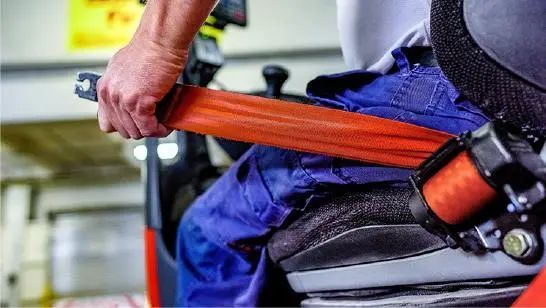Forklifts are critical pieces of equipment widely used in industry and logistics to improve work efficiency and the safety of material handling. However, like any mechanical equipment, there are certain risks associated with the use of forklifts.

While ensuring workplace safety, special attention should be paid to wearing and using seat belts correctly when using forklifts.
This article will explain the importance of forklift seat belts and provide some safety tips to ensure safety when using a forklift.
Seat belts are a simple but critical piece of equipment that protects drivers in the event of an accident. In a car, seat belts prevent the driver and passengers from moving forward in the event of a front-end collision.
On forklifts, seat belts secure the operator to the seat to prevent tipping. It's human nature to want to "jump" in a tip-over situation, and you're likely to jump in the direction of the tip-over. However, once the forklift starts tipping, you can't get off the machine fast enough to avoid injury.
The importance of forklift seat belts
protect the driver
Seat belts prevent driver injury in the event of a collision or other unexpected situation. It spreads impact force over a wider area of the body, reducing the risk of head, neck and chest injuries.
Prevent tip-over accidents
In some cases, forklifts may be at risk of tipping over, especially when operating in high stacks or on uneven surfaces. Seat belts help drivers stay in the driver's seat and reduce injuries caused by rollover accidents.
Protection against spilled or dropped objects
When transporting items on a forklift, especially when stacking high, if you suddenly stop or make a sharp turn, the items may fall from the forks. A driver wearing a seat belt keeps them stable and reduces the risk of injury.
How to stay safe if forklift tipped over?
1. Always fasten your seat belt every time you drive a forklift, and adjust the seat belt as needed.
2. Push the steering wheel hard and put your feet firmly on the floor of the forklift so that you are firmly seated on the seat.
3. Put your hands on the steering wheel, lean forward, and use the steering wheel as a support for your upper body.
4. Always stay away from the point of impact. For example, if the forklift is leaning to the left, lean to the right.
Forklift Safety Belt Use Suggestions
Make sure the seat belt fits
Choose the correct size seat belt and make sure it is adjusted correctly. Fasten the seat belt around your waist or shoulders and keep it safe and secure.
Adjust the tightness of the seat belt
Adjust the seat belt so that it fits snugly but not too tight or too loose. A seat belt that is too tight can be uncomfortable and restrict the driver's movement, while a seat belt that is too loose cannot provide effective protection. Make sure you are able to move freely during forklift operation, but protect you in the event of an accident.
Make sure the seat belt is fastened
After wearing the seat belt, make sure it is properly fastened. Make sure the seat belt is fastened and locked to ensure effective protection in all conditions.
Forklift safety belt use safety tips
Don't unbuckle your seat belt
Never unbuckle the seat belt while operating the forklift. Seat belts should not be unbuckled even for brief stops or when repositioning is required. Only remove the seat belt and leave the driver's seat when you have come to a complete stop and ensured that the surrounding environment is safe.
Check seat belts regularly
Check seat belts regularly for wear and damage. If you notice any signs of damage or looseness, the seat belt should be replaced immediately to ensure that it will provide protection when required.
Training and Awareness Education
In addition to wearing seat belts, drivers should also receive forklift operation training and understand the importance of seat belts. Provide employee training and awareness education to let them understand the importance of wearing seat belts and comply with relevant safety regulations and operating procedures.
Wearing and properly using a seat belt is essential when using a forklift. Seat belts protect drivers in accidents and emergencies and reduce the risk of injury.
Workplace safety can be greatly improved through compliance with seat belt use, training and awareness.
Remember, wearing a seat belt is not only a legal requirement, but a fundamental responsibility to keep yourself and others safe.

 Forklift Red Zone Warning Light
Forklift Red Zone Warning Light
 HITOP CPD20 CPD16 electric forklifts are exported to the Netherlands and Cayman Islands Respectively
HITOP CPD20 CPD16 electric forklifts are exported to the Netherlands and Cayman Islands Respectively
 The Basics of Forklift Tire Maintenance
The Basics of Forklift Tire Maintenance
 Four 3-ton HITOP diesel forklifts with Mechanical transmission are ready for Indonesia
Four 3-ton HITOP diesel forklifts with Mechanical transmission are ready for Indonesia